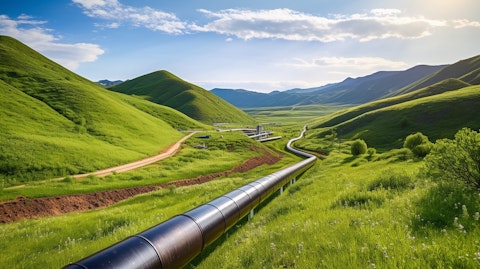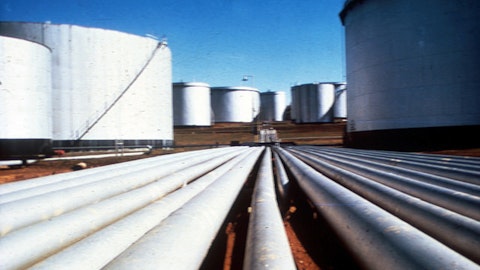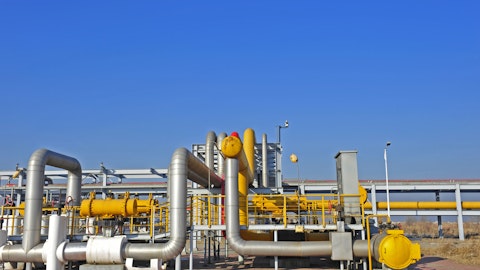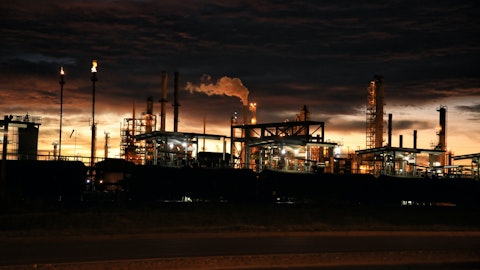Plains All American Pipeline, L.P. (NASDAQ:PAA) Q3 2023 Earnings Call Transcript November 3, 2023
Operator: Good day and thank you for standing by. Welcome to Plains All America’s Third Quarter 2023 Earnings Conference Call. At this time, all participants are in a listen-only mode. After the speaker’s presentation, there will be a question-and-answer session. [Operator Instructions] Please be advised that today’s call is being recorded. I would now like to hand the conference over to your speaker today, Blake Fernandez, Vice President, Investor Relations. Please go ahead, sir.
Blake Fernandez: Thank you, Norma. Good morning and welcome to Plains All American third quarter ’23 earnings call. Today’s slide presentation is posted on the Investor Relations website under the News and Events section at plains.com. An audio replay will also be available after today’s call. Important disclosures regarding forward-looking statements and non-GAAP financial measures are provided on Slide 2. An overview of today’s call is provided on Slide 3. A condensed consolidating balance sheet for PAGP and other reference materials are in the appendix. Today’s call will be hosted by Willie Chiang, our Chairman and CEO; and Al Swanson, Executive Vice President and CFO as well as other members of our management team. With that, I will turn the call over to Willie.

A long pipeline snaking through a rural landscape – symbolizing the companies midstream energy services.
Willie Chiang: Thanks, Blake. Happy Friday, everyone and thank you for joining us this morning. Today, we reported strong third quarter results, along with the closing of 2 Permian gathering bolt-on acquisitions and the continued execution of our multiyear capital allocation framework which is focused on lowering leverage and increasing the return of capital to our unitholders. As a result of our year-to-date performance and the partial year contributions of our recent bolt-on acquisitions, we are raising our full year 2023 adjusted EBITDA guidance to a range of $2.6 billion to $2.65 billion. This reflects an increase of $50 million to $100 million from the high end of our previous guidance range a high-level overview of our updated 2023 guidance is located on Slide 4 and Al will share additional detail in his portion of the call.
As summarized on Slide 5, OMAG JV acquired Rattler Midstream’s Southern Delaware Basin crude gathering system and LM Energy’s Northern Delaware Basin touchdown crude gathering system for an aggregate cash consideration of approximately $205 million or approximately $135 million net Plains. These bolt-on acquisitions are expected to generate unlevered returns in line with our return thresholds of approximately 300 to 500 basis points above our weighted average cost of capital, in addition to enhancing our position in the Delaware Basin. The assets will further position the Permian JV to expand its service and offerings and extend commercial relationships with both new and existing customers. Regarding today’s capital allocation update, we continue to make meaningful progress towards our goal of lower absolute debt and maintaining a strong balance sheet that can withstand various commodity cycles.
As highlighted on Slide 6, we are lowering our long-term leverage ratio target range to 3.25x to 3.75x. This is intended to be a long-term range target range where we may operate below the low range — the low end of the range during certain periods or temporarily above the top end of the range in the event of strategic transactions with a goal of moving back into the target range on a long-term basis. We expect to exit the year below 3.5x due to a reduction in net debt of approximately $450 million which is underpinned by the repayment of $1.1 billion of senior notes in 2023. In further support of our capital allocation framework laid out in November 22, we intend to recommend to our Board a $0.20 per unit annualized increase in our quarterly distribution payable in February of 2024 as seen on Slide 7.
On an annualized basis, the distribution would increase from $1.07 per unit currently to $1.27 per unit, representing a 19% increase. I would also note the proposed acceleration and timing of our annual distribution increase which would fully increase forward from our May timing to February. This is all consistent with our objective of increasing returns to our unitholders and it reflects our continued confidence in our business which is bolstered by the benefits from the recent bolt-on acquisitions. Long term, our free cash flow generation continues to support our multiyear capital allocation framework which continues to target annualized distribution increases of approximately $0.15 per unit each year until reaching a target common unit distribution coverage of approximately 160%.
With that, I’ll turn the call over to Al.
Al Swanson: Thanks, Willie. We reported third quarter adjusted EBITDA attributable to PAA of $662 million. This reflects the benefit of annual tariff escalators, higher volumes in regions outside of the Permian, contribution from recent bolt-on acquisitions and the benefit of market-based opportunities. These were partially offset by lower-than-expected Permian volumes due to weather-related impacts on gas processing capacity and field compression issues that ultimately impacted oil production and extended into the middle of August. The NGL segment benefited from stronger regional basis differentials and additional spot opportunities on both propane and butane, resulting in higher realized frac spreads. Slides 12 and 13 in today’s appendix include walks which provide more detail on our third quarter performance.
A summary of our updated 2023 guidance is located on Slide 8. As a result of strong year-to-date business performance in both our crude and NGL segments and the contributions from our recent bolt-on acquisitions, we are raising our full year 2023 adjusted EBITDA guidance to $2.6 million to $2.65 billion. Our updated outlook factors in lower-than-expected Permian production, predominantly driven by the weather-related impacts. We continue to expect year-over-year growth in our crude oil segment driven by tariff volume increases and tariff escalation. For the NGL segment, we remain highly hedged and expect a typical seasonal step-up in sales as we enter the winter months. Shifting to capital allocation, as illustrated on Slide 9. For 2023, we expect to generate $2.45 billion in cash flow from operations and $1.45 billion of free cash flow which takes into account the cash outlay for our recently announced bolt-on acquisitions.
This results in $450 million of free cash flow after distributions available for net debt reduction. We continue to self-fund $325 million of investment capital net to PAA which is consistent with previous guidance. We have increased our maintenance capital budget by $15 million to $210 million net to PAA for 2023. This reflects additional maintenance capital for recent bolt-on acquisitions and higher integrity maintenance activity for the year. Before turning the call back to Willie, I wanted to share a few directional comments in 2024 with formal guidance to come early next year. We continue to expect growth in our crude oil business primarily driven by operating leverage, continued Permian growth, tariff escalation and full year contributions from bolt-on acquisitions.
In our NGL segment, we have seen volatility in frac spread but have made meaningful progress in hedging over 2/3 of our expected 2024 frac exposed volumes at a spread above $0.60 per gallon. Additionally, we should benefit from the absence of planned turnaround activity next year which negatively impacted commodity exposed volumes in 2023. With that, I’ll turn the call back to Willie.
Willie Chiang: Thanks, Al. Before finishing today’s call, I want to reiterate a few key messages. First, current global events have highlighted and reaffirmed the importance of hydrocarbons in everyday life. Plains remains very well positioned as North American supply will continue to be critical to global energy security, affordability and reliability. Secondly and importantly, our business remains strong. We continue to execute our strategy of generating meaningful cash flow, maintaining capital discipline, reducing leverage and increasing return of capital to our unitholders. And lastly, we continue to have confidence in our business which is built on an integrated flexible asset base with operating leverage across our system.
We appreciate your continued interest and support and we look forward to fielding your questions as well as giving you further formal updates on our earnings call for 2024 in February. With that, I’ll turn the call over to Blake to lead us into Q&A.
Blake Fernandez: Thanks, Willie. As we enter the Q&A session, please limit yourself to 1 question and 1 follow-up. For those with additional questions, please feel free to return to the queue. This will allow us to address questions from as many participants as possible and are available time this morning. Additionally, the IR team will be available to address any additional questions you may have. Norma, I believe we’re ready to open up the call to questions.
See also 11 Best Stocks to Buy for Income and 11 Best November Dividend Stocks To Buy.
Q&A Session
Follow Plains All American Pipeline Lp (NYSE:PAA)
Follow Plains All American Pipeline Lp (NYSE:PAA)
Operator: Thank you. [Operator Instructions] Our first question comes from the line of Michael Blum with Wells Fargo.
Michael Blum: I wanted to first ask just about the bolt-on acquisitions of the Permian. Do you expect this to be kind of normal course? Do you see more opportunities to consolidate in the Permian? And then kind of second part of that is do you see — should we expect to see any kind of — any of this type of activity outside of the Permian.
Willie Chiang: Yes. Let me speak to the bolt-ons, Michael. It’s a good question. As you know, we’ve got a great footprint that allows us to capture synergies and opportunities that are out there. We do think there are more opportunities. We’re going to be very, very disciplined in how we approach it. The valuations are going to be key. And I think you’ll see continued focus on that. We look at all opportunities because our interest are in the best interest of our unitholders but I think you’ll see both bolt-on opportunities in both the Permian and outside of the Permian.
Michael Blum: Okay, great. And then, my second question is probably related to the first. The rationale for reducing the leverage target, maybe you could just walk through that? And is that in any way related to what you see down the road in terms of M&A and having the flexibility to act there.
Al Swanson: Michael, this is Al. Our view was, as we intended to be running the company at a lower leverage than what we had been historically. Part of the reason for committing to it publicly like we have is our intent lets to do it. Two, we believe the broader energy sector is and will be running with lower leverage. And we want to actually complete and get our upgrades to mid-BBB. And we think this range that we’ve established puts us subtly in that with some flexibility for that and recognizing, again, that our intent is to run the company a little bit more conservatively with the balance sheet.
Operator: One moment for our next question, please. Our next question comes from the line of Brian Reynolds with UBS.
Brian Reynolds: Thanks for the prepared remarks on the impacts on volumes in the Permian’s quarter related to weather, it sounds like — but kind of just wanted to follow up on the Permian outlook here. First part of the question is, are you seeing any recent crude gathering acquisitions in the basin kind of impact volumes for the quarter or going forward? And then second part, maybe a little more longer-dated question. We’ve heard some very constructive Permian growth expectations into ’24 into ’25. I’m just curious if you can kind of give us an early look of what you’re seeing for Permian activity as we look ahead to next year.
Willie Chiang: Brian, I’m glad you asked the question. This is Willie. We’ll give — first off, we’ll give you a formal guidance in February on 2024 in the Permian but I’ll give you some snapshots here. This has been a little bit of a strange year in that we had some weather issues in the summer that really impacted both second and third quarter. Our original guidance for the year was 500,000 barrels a day growth exit to exit. We updated on our last call that we thought it was going to be a little bit below that. Our views now is it’s probably in that $350 to $400 range for the year. But the thing I wanted to share with you is if you look at our October volumes and gathering, this may address your question, we’re actually 175,000 barrels a day higher in October than we were for the third quarter.
So it really gives us confidence in the fourth quarter. You never can perfectly predict the future but we are seeing increased volumes as we start the fourth quarter off and then certainly, a lot of the recent announcements, particularly with 1 of the large transactions in 1 of the very large super majors really lends support and aligns our view of the Permian going to be around for a long, long time as we go forward.
Brian Reynolds: Great. Appreciate that. And maybe to touch on the distribution, it seems to come up a little bit above expectations from last year’s capital allocation update. So kind of curious if you can refresh us. Are there any structural changes that we’d be thinking about? Or is kind of targeting that 1/6 [ph] coverage over a multiyear framework, still the right way to think about it? And how ultimately some of these acquisitions impact that distribution outlook going forward.
Al Swanson: Yes, this is Al. We still are committed in the future for the $0.15 annual increase in the 160% coverage at the common level. Part of the reason for moving it up and the extra nickel list is related to the acquisitions that we’ve completed. They’re accretive. Again, we’ve targeted hurdle rates that will bring good accretion for these bolt-on transactions and we also have seen strong performance out of our business. But once we complete this, we’re back to the $0.15 and 160% coverage. We think the 106% coverage allows us to basically fund investment capital going forward and number of small bolt-ons in the future without actually needing to raise external money. So kind of live in our own cash flow means.
Brian Reynolds: Great. I’ll make sense. I’ll leave it there.
Operator: One moment for our next question, please. Our next question comes from the line of Gabriel Moreen with Mizuho.
Gabriel Moreen: Maybe, Willie, if I can just ask a follow-up on Michael’s question about recurring bolt-on M&A you mentioned looking at things outside the Permian. Can you maybe elaborate on which basins you might think about as far as doing those bolt-ons and is doing something like the Oryx JV structure appealing to you in other basins outside the Permian as well?
Jeremy Goebel: Gabriel, this is Jeremy Goebel. I would say we’re structure agnostic. We’re just trying to basically garner the most synergies in a way that works for us and the counterparty. Where we would focus, it’s where we have strength. I’d say, from our vantage point, we have gathering assets in all the core where we have a strength in our marketing business, our pipeline business and our terminals, we can add value to assets. We’ll continue to look there if you look across our footprint, where we have strength is an area where we think we can add value and extract synergies into accretive deals and the manner that Al just mentioned, that’s where we’re going to target.
Gabriel Moreen: And then maybe if I can ask about sort of the hedging of the frac spread exposure heading into ’24. Just you mentioned you had put a lot of the spread exposure to that at this point? Are you close to that 80% level that you’re targeting? Do you see yourself getting there near term? Or are you kind of leaving some stuff open in anticipation of some strength?
Willie Chiang: Yes, Gabe, we’re not going to disclose the exact number but Al’s comments on well over 60% hedged was really indicative of — that we’ve got a good portion of this hedged at good values and we’ll give a further update when we get into February.
Operator: One moment for our next question. Our next question comes from the line of Keith Stanley with Wolfe Research.




